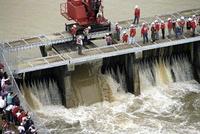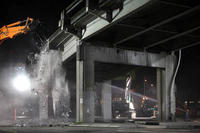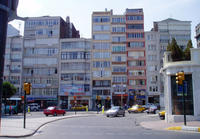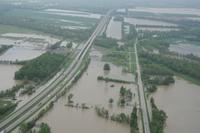-
U.K. lab helps company improve its infrastructure monitoring sensors
London-based Senceive produces sensors used in long-term infrastructure monitoring; the company’s meshed systems of wireless sensors are used to assess the condition of railway structures, track, bridges, culturally significant buildings, and even historical artifacts; the company needed the help of the U.K. National Physical Laboratory to improve the tilt sensing system it manufactures, and verify its accuracy, precision, and limits
-
-
Sector Report for Monday, 16 May 2011: Infrastructure protection
This report contains the following stories.
-
-
Historic, desperate measures to control Mississippi River

The historic levels of water swelling the Mississippi River required the Army Corps of Engineers to take historic measures to prevent catastrophic flooding of Baton Rough and News Orleans: first, the Morganza control structure, located 186 miles upriver of New Orleans and completed in 1954 as part of the Army Corps of Engineers’ broad flood-protection upgrades in the wake of the Great Flood of 1927, was opened for only the second time to allow water to flow out of the river and into the Atchafalaya basin, a designated flood relief area; the Corps says that Saturday marked the first time in history that all three floodways built by corps after 1927 flood — the Morganza Floodway, the Bonnet Carre Spillway, and the Birds Point floodway in Missouri — have been in operation at the same time; about 25,000 people and 11,000 structures are in harm’s way, as up to 25 feet of flooding is expected in a 3,000 square-mile area of Louisiana
-
-
How safe are U.S. railroads?
Following the revelation that al Qaeda had aspired to attack U.S. railways, security experts, the media, and lawmakers have turned their attention to improving security for American trains; in a recent interview with CNN, Brian Michael Jenkins, the director of the Mineta Transportation Institute’s (MTI) National Transportation Security Center of Excellence, discussed the current state of railway security, how realistic creating an airline style screening system for railroads would be, and what measures need to be taken to secure railroads; to realistically improve rail security in a cost effective manner, Jenkins urged passengers to begin taking a more active role; Jenkins also urged the United States “to be more realistic about risk”
-
-
Rebuilding Seattle's viaduct will not result in nightmare commutes

Debate about how to replace Seattle’s deteriorating waterfront highway has centered on uncertainties in the project’s price tag; drilling a deep-bore tunnel and building an underground highway is estimated to cost around $4 billion, but some worry the final price could be higher, as it was for Boston’s infamous Big Dig; University of Washington statisticians have, for the first time, explored a different subject of uncertainty, namely: how much commuters might benefit from the project
-
-
Informed response to threat of asteroid collision

Surveys using ground and space-based telescopes, such as the NASA Spaceguard, have identified many Near Earth Objects (NEOs) that pass close to the Earth, including the 400 meter asteroid 2005 YU55 which will approach to within 325,000 km of the Earth in November this year; early detection of NEOs, and determination which of them is more threatening to Earth, are essential for decisionmakers; Southampton University researchers developed a new software system that could support decisions on how to respond to potential NEO impacts on Earth
-
-
Turkey plans two earthquake resistant cities to move residents from vulnerable Istanbul

To encourage residents to move away from seismically unsafe neighborhoods, Turkey’s government recently announced that it will begin building two earthquake-resistant developments near Istanbul; the city of more than twelve million people currently sits near a major fault-line that could potentially kill thousands in the event of a major earthquake; engineers and seismic experts warn that Istanbul’s poor construction, shoddy city planning, and overcrowding would result in many fatalities in the event of an earthquake; officials plan for the new urban centers to be home to roughly 1 million residents each; any move to the new settlements would be entirely voluntary
-
-
Direct removal of carbon dioxide from air infeasible
A group of experts looked at technologies known as Direct Air Capture, or DAC, which would involve using chemicals to absorb carbon dioxide from the open air, concentrating the carbon dioxide, and then storing it safely underground; they conclude that these technologies are unlikely to offer an economically feasible way to slow human-driven climate change for several decades
-
-
New technology quickly detects bioattacks on water supply systems
If pathogens enter into a city water supply network, many people may fall ill quickly; to protect against this biological threat, researchers have developed a detection system, partly based on nanotechnology, that can warn authorities in time
-
-
Missouri levee blast floods 130,000 acres, but saves Illinois city

On Tuesday, the U.S. Army Corps of Engineers blasted a section of a levee along the Mississippi River to create a controlled breach that would relieve pressure and prevent the town of Cairo, Illinois from becoming engulfed in record flood levels; the blast created a gap more than 10,000 feet wide at Birds Point, Missouri levees and inundated more than 130,000 acres of farmland; heavy rains have left the Mississippi and Ohio Rivers swollen, putting Cairo and its 3,000 residents at great risk as it sits on a narrow stretch of land between the two surging rivers; on Monday, the Corps received permission from the federal government to go ahead with its plan, despite Missouri’s protests
-
-
What past rises of sea levels tell us about future rises
During a period of high atmospheric carbon dioxide levels three million years ago — the mid-Pliocene climate optimum — sea levels were anywhere between 15 and 100 feet higher than at present because water that is now locked up in glaciers as ice circulated freely through the oceans; by understanding the extent of sea level rise three million years ago, scientists hope more accurately to predict just how high the seas will rise in the coming decades and centuries due to global warming
-
-
Sector Report for Monday, 2 May 2011: Infrastructure protection
This report contains the following stories.
Plus 1 additional story.
-
-
California school building regulators had ties with anti-regulation lobby group
A California watchdog group recently revealed that state officials in charge of enforcing earthquake standards for school buildings have had a long and questionable relationship with a lobbying group that actively works to oppose building safety regulations in public schools; senior officials with the Division of the State Architect had been dues paying members of the Coalition for Adequate School Housing, which actively lobbies for less regulation on school construction; in 1997, state regulators were told that taxpayers would reimburse their membership dues to be a part of the lobbying group; officials maintain that there has been no corruption; in 2010 a major regulatory provision in place since 1933 was removed
-
-
New guide explains perimeter protection options
A new guide explains the subject of perimeter protection clearly and concisely to enable specifiers, facilities managers, security managers, and consultants to identify the optimum security measures for particular premises and threats; it covers not only high-security fencing, barriers, and gates, but also electric pulse systems and associated security measures such as access controls, CCTV, and intrusion detection systems
-
-
PG&E send safety information to customers living near gas pipelines
PG&E begins notifying customers of gas transmission pipeline locations and highlights actions the company is taking to make natural gas transmission lines safer; the letter safety brochures is being to 2.5 million homeowners and businesses located within about 2,000 feet of a natural gas transmission pipeline
-
- All
- Regional
- Water
- Biometrics
- Borders/Immig
- Business
- Cybersecurity
- Detection
- Disasters
- Government
- Infrastructure
- International
- Public health
- Public Safety
- Communication interoperabillity
- Emergency services
- Emergency medical services
- Fire
- First response
- IEDs
- Law Enforcement
- Law Enforcement Technology
- Military technology
- Nonlethal weapons
- Nuclear weapons
- Personal protection equipment
- Police
- Notification /alert systems
- Situational awareness
- Weapons systems
- Sci-Tech
- Sector Reports
- Surveillance
- Transportation
Advertising & Marketing: advertise@newswirepubs.com
Editorial: editor@newswirepubs.com
General: info@newswirepubs.com
2010-2011 © News Wire Publications, LLC News Wire Publications, LLC
220 Old Country Road | Suite 200 | Mineola | New York | 11501
Permissions and Policies
Editorial: editor@newswirepubs.com
General: info@newswirepubs.com
2010-2011 © News Wire Publications, LLC News Wire Publications, LLC
220 Old Country Road | Suite 200 | Mineola | New York | 11501
Permissions and Policies
